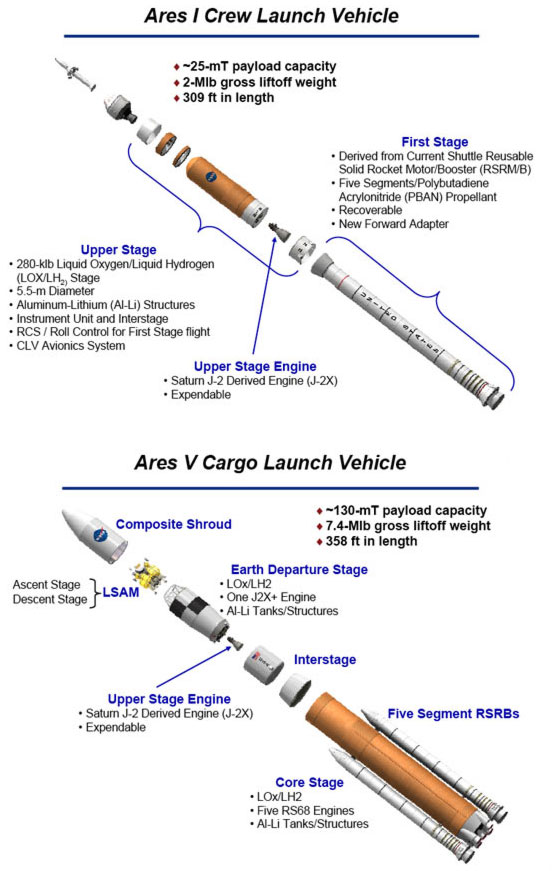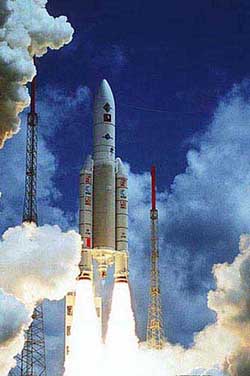Skip to comments.
Old rocket science tied to today's at Marshall
The Birmingham News ^
| 8/10/2006
| Kent Faulk
Posted on 08/12/2006 5:27:28 AM PDT by Paul Ross
click here to read article
Navigation: use the links below to view more comments.
first 1-20, 21-35 next last
Ares I and Ares V are being designed so they can fly in all types of weather, which the shuttle can't do, NASA engineers said. H'mmm. Is this particular specification wise? Just because the Russians got away with it with Soyuz...i.e., here is Michael Cabbage's (Space Writer, Orlando Sentinal) posting relating to this:
NASA is designing the Ares 1 to lift off in much more marginal weather than the space shuttle. The goal is to create a vehicle more like Russia’s Soyuz booster, which has been launched in rain, high winds, fog and snowstorms. The first test flight of the rocket, dubbed Ares I-1, is scheduled for April 2009. The test will use an adapted four-segment booster from the shuttle program instead of the slightly longer five-segment version planned for operational flights. The second stage will consist of a dummy payload.
1
posted on
08/12/2006 5:27:29 AM PDT
by
Paul Ross
To: Paul Ross
Hope they use some good o-rings in those boosters.
2
posted on
08/12/2006 5:42:42 AM PDT
by
Ninian Dryhope
("Bush lied, people dyed. Their fingers." The inestimable Mark Steyn)
To: Paul Ross; Ninian Dryhope
The lower, or first stage, of the Ares I will be a juiced-up version of the reusable solid-fuel rocket boosters made by ATK Thiokol for space shuttle launches. I never have liked solid-fueled rocket boosters for manned space flight.
Even if they were 100% reliable once they are lit you can’t shut them down.
If something totally unrelated to the booster themselves goes wrong you have to wait till they have completed their burn to jettison the booster.
3
posted on
08/12/2006 5:52:26 AM PDT
by
Pontiac
(All are worthy of freedom, none are incapable.)
To: Paul Ross
I hope the only piece of engineering they take from the shuttle over what they had on Apollo is, uhhhhhhhhh Hmmmmmmmmm. I'll have to get back with you.
4
posted on
08/12/2006 6:00:16 AM PDT
by
SengirV
To: Paul Ross
Is this particular specification wise? It should lead to a more predictable, more economic space program. Designing aircraft to fly in "all weather", did the same for airline service. Of course, "all weather" isn't all weather, but rather all reasonable weather. Just out of curiosity, you didn't go to High School in Missouri did you Paul?
5
posted on
08/12/2006 6:09:43 AM PDT
by
SampleMan
To: Paul Ross
Marshall Space Flight Center engineers have enlisted the help of retired rocket scientists, dug through archives and taken parts off museum pieces as they look toward mixing Apollo and space shuttle technology with later innovations into the Ares I and Ares II rockets. Last week I read that the plans for the Saturn V have been lost (along with the raw videotape of the moon landing). Maybe someone here knows if that is true.
To: Paul Ross
Who was it who said, "The more things change, the more things stay the same."?
7
posted on
08/12/2006 6:31:22 AM PDT
by
Corey Ohlis
(Visualize Swirled Peas)
To: Paul Ross
So after the multi billion dollar shuttle, we are going back to the man in a can approach.
Which works ok and is cheaper.
8
posted on
08/12/2006 6:46:32 AM PDT
by
redgolum
("God is dead" -- Nietzsche. "Nietzsche is dead" -- God.)
To: SampleMan
Just out of curiosity, you didn't go to High School in Missouri did you Paul?Nope, Minnesota.
9
posted on
08/12/2006 6:51:42 AM PDT
by
Paul Ross
(We cannot be for lawful ordinances and for an alien conspiracy at one and the same moment.-Cicero)
To: Ninian Dryhope
Hope they use some good o-rings in those boosters.It probably wouldn't matter if there were an O-Ring burn through on Ares I, as the fuel tank on that one (for the upper stage in this case) will be up on top of the SRB, not next to it. A burn through could screw up the trajectory, but shouldn't cause an explosion on Ares I.
On Ares V, if I get this right, it will look like the Shuttle tank with two SRBs attached directly to it as on the current Shuttle stack, but the rest of the stack goes on top as well. There are also liquid fuel engines beneath the tank. Frankly it will look much more like Russia's Energia or France's Ariane 5 when it's all up.
Ares I and Ares V

Energia vertical stack configuration:

Or the French Ariane 5:

10
posted on
08/12/2006 6:55:03 AM PDT
by
Phsstpok
(Often wrong, but never in doubt)
To: Ninian Dryhope
Hope they use some good o-rings in those boosters.There is no external tank to be breached and detonated on a vertical stack approach.
And the O-rings were fixed after Challenger. And even now, just to be extra-safe for the shuttle, they launch only in warm days so the material is at its most effective to seal...
11
posted on
08/12/2006 6:58:56 AM PDT
by
Paul Ross
(We cannot be for lawful ordinances and for an alien conspiracy at one and the same moment.-Cicero)
To: Paul Ross
H'mmm. Is this particular specification wise? It is good to not be sensitive to weather conditions. It is wise to not push your capabilities unless you really need to.
I would hope they do not try "bad weather takeoff" for anything but emergency rescue missions
12
posted on
08/12/2006 7:05:06 AM PDT
by
SauronOfMordor
(A planned society is most appealing to those with the arrogance to think they will be the planners)
To: wideminded
Dont know about the Saturn plans, but R. Hoblein(sp?) was on the Art Bell Show (yeah, I know) a few weeks ago talking about how there are 700 boxes of raw footage, etc missing from the archives of the 1st moon landing.
?????
13
posted on
08/12/2006 7:15:45 AM PDT
by
carmenbmw
(My cats name is Mean. He earned it.)
To: Paul Ross
Another moon landing in 2020? 14 years from now? Pretty pathetic.
14
posted on
08/12/2006 8:04:54 AM PDT
by
dr_who_2
To: Paul Ross
gather 28 of the "graybeards"...GM should do the same. Take apart a '63 Chevy and find out how the thing lasted 40 years and apply that to todays hunks of plastic junk.
15
posted on
08/12/2006 8:22:18 AM PDT
by
JOE6PAK
(FAKE, but ACCURATE!)
To: Pontiac
If something totally unrelated to the booster themselves goes wrong you have to wait till they have completed their burn to jettison the booster. With the solid boosters currently on the Shuttle, they still have a little fuel left over at the end of their burn phase.
I think the main reason for this is that they want to make sure that thrust from both boosters ends within a small fraction of a second; otherwise, the induced yaw would destroy the vehicle.
But they can't make a solid booster burn so precisely that it exhausts its fuel within a small fraction of a second of a nominal period. So, they equip the booster with a pyrotechnically-actived vent at the top.
When the solid boost phase is complete, they blow the vents on the boosters simultaneously, and this cuts off thrust immediately even though there's a small bit fuel remaining (varying slightly among the boosters).
Maybe solid boosters can be designed to be capablie of this early in the burn, for emergency aborts.
Restarts are not feasible in any solid booster design I know of, but present-day designers don't see this as a problem, so long as they add a liquid-fuel booster which gives a part of the total thrust, and which burns beyond the duration of the solid boosters.
16
posted on
08/12/2006 9:28:24 AM PDT
by
Erasmus
(<This page left intentionally vague>)
To: Pontiac
But if the crew capsule can separate or eject that should solve that problem.
17
posted on
08/12/2006 9:34:35 AM PDT
by
Moonman62
(The issue of whether cheap labor makes America great should have been settled by the Civil War.)
To: Paul Ross
Ares I and Ares V are being designed so they can fly in all types of weather, which the shuttle can't do, NASA engineers said. H'mmm. Is this particular specification wise?
From someone who thinks the current manned space program is a tragic joke, I think it's very wise. Can you imagine a commercial service surviving with the same delays as the Shuttle?
18
posted on
08/12/2006 9:36:52 AM PDT
by
Moonman62
(The issue of whether cheap labor makes America great should have been settled by the Civil War.)
To: Paul Ross
The original engineers of the space program did most of their calculations on slide rules. I wonder if having laptops is going to speed the process up. One can only hope!
NO2
19
posted on
08/12/2006 9:37:40 AM PDT
by
No2much3
(I did not ask for this user name, but I will keep it !)
To: dr_who_2
Another moon landing in 2020? 14 years from now? Pretty pathetic. Yes it is. They should shutdown the Shuttle and ISS, and get to it.
20
posted on
08/12/2006 9:42:54 AM PDT
by
Moonman62
(The issue of whether cheap labor makes America great should have been settled by the Civil War.)
Navigation: use the links below to view more comments.
first 1-20, 21-35 next last
Disclaimer:
Opinions posted on Free Republic are those of the individual
posters and do not necessarily represent the opinion of Free Republic or its
management. All materials posted herein are protected by copyright law and the
exemption for fair use of copyrighted works.
FreeRepublic.com is powered by software copyright 2000-2008 John Robinson
![]()

